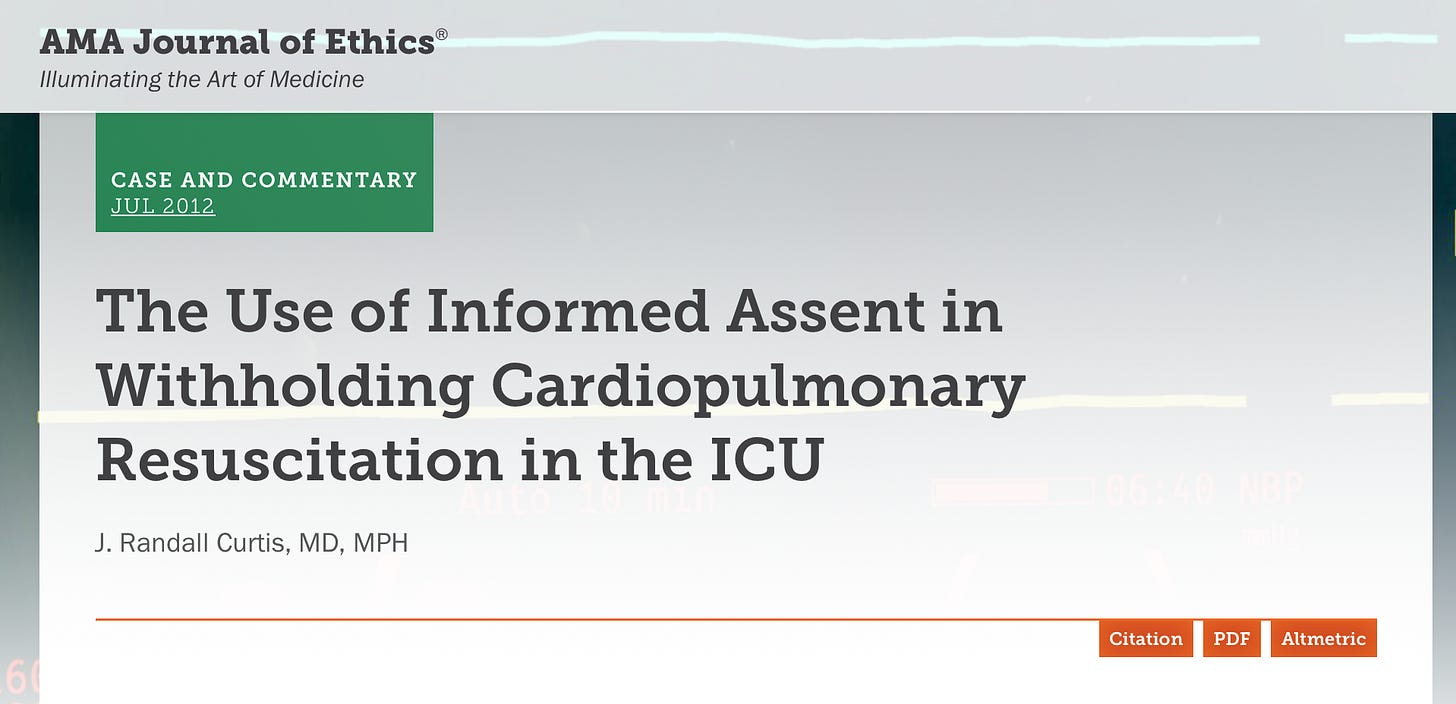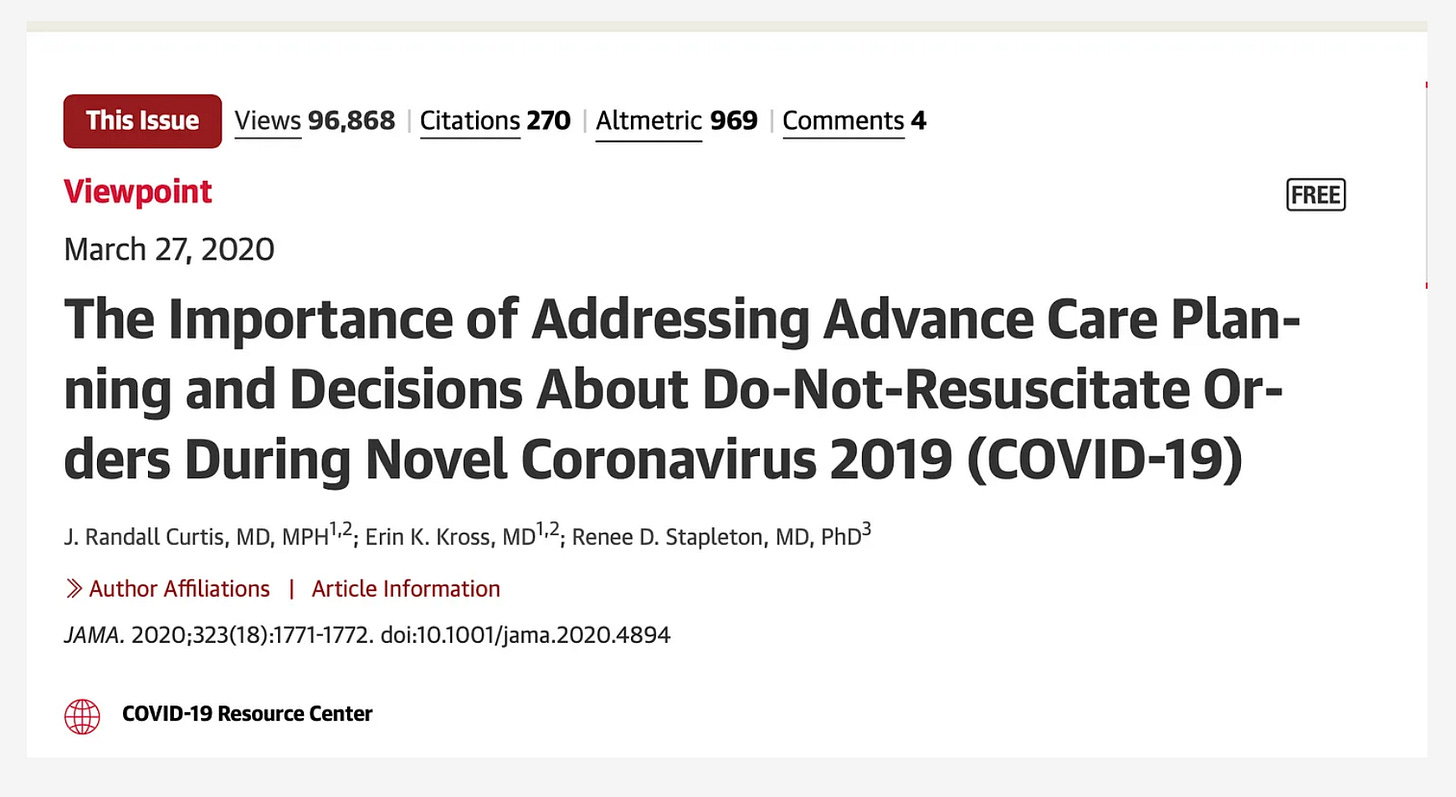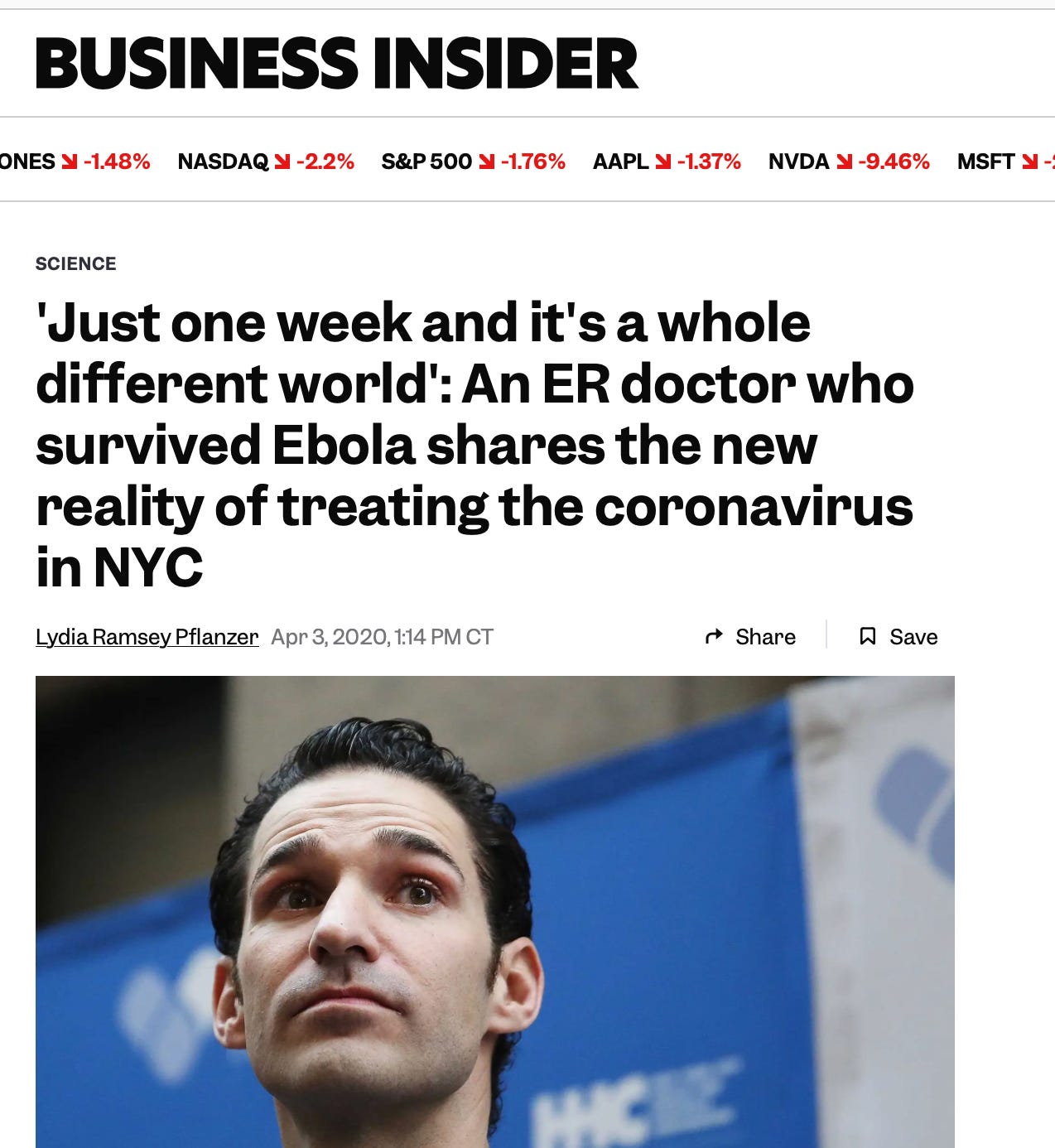Follow-Up on 'Informed Assent': More Signs that Spring 2020 Was...Not What it Seemed to Be
Using Doctors to psy-op Doctors is a crime
Writing about the DNR-related death of Dimitrios Katsaros introduced me, a non-MD, to the concept of informed assent. While I’m well-versed in informed consent, I had not previously encountered informed assent.
said the phrase was new to him too and called it an “Orwellian abomination.”I agreed and felt compelled to learn more.
So, I turned to my sister, Dr. Kelly Frazier. Here’s our conversation, shared verbatim via text (with her permission):
Jessica: Have you heard of informed assent?
Kelly: Yes - usually reserved for situations involving family that may be having some alternative motivation for keeping a family member alive, or situation more like wartime or Ebola [outbreak].
Jessica: Good to know - and very helpful. What’s the difference between informed consent and informed assent?
Kelly: Informed assent is trying to get the family to agree or be okay with a decision the doctors have made. Informed consent is when we need the families’ permission in order to do something.
Jessica: Thanks. Is “informed assent” a concept discussed in the medical literature then?
Kelly: Informed assent is also used a lot in pediatrics where we don’t need a child’s consent to start chemotherapy since we get that from parents, but we would want to get a 15yo’s assent to what is about to happen. I think it’s more applied to pediatrics than other areas, but of course, I don’t work in other areas.
Jessica: But you said "wartime or Ebola". You have worked in the latter.
Kelly: Yes. We would apply informed assent to an Ebola ward where patients don’t get fully coded as a standard of safety for nursing/doctor safety.
Jessica: Recall my hypothesis: I believe a chemical attack/war simulation was activated.
Kelly: Sure - in my opinion, hospitals definitely treated COVID like an Ebola-type protocol (which all hospitals have those protocols in place) and were activated to act under those guidelines.
Kelly was living and working in West Africa in 2020 when the WHO declared a pandemic. She stayed in contact with doctors across multiple countries while also following social media and news, observing what appeared to be happening.1
Based on her definitions and a quick internet search, I got the impression that informed assent essentially means the doctor saying, 'We’re going to do this to you, your child, or your loved one. We need you to acknowledge that we informed you, but we’re proceeding regardless of any misgivings or objections you may have.'"
I can see how it would be necessary in pediatrics, end-of-life care, and, as Kelly noted, true disaster medicine situations. However, as a general principle—or a recommended practice during a manufactured emergency—it’s indefensible.
Attempting to trace the origins of the term, I found a 2012 commentary in the AMA Journal of Ethics titled “The use of informed assent in withholding cardiopulmonary resuscitation in the ICU.” The author - J. Randall Curtis - is also the lead writer on the March 2020 JAMA opinion.2
Curtis and a colleague conceived informed assent in the wake of battles over the Texas Advance Directives Act and overarching ethical dilemmas as a bridge between unilateral (one-way, doctor-decided) DNRs and informed consent.
Curtis defined informed assent situationally as when “the family is explicitly offered the choice to defer to clinicians’ judgment about withholding or withdrawing life-sustaining therapy” that “may be an appropriate and ethical alternative to requiring informed consent.”
He went on to say,
In the application of informed assent, we believe that clinicians should provide full information about the risks and benefits of expected or requested treatments, convey specific recommendations about the medically proposed course, and clearly indicate that the patient and family are being invited to defer to the clinicians’ judgment. This is similar to the conventional conception of informed consent—an informed patient or family member can always make an affirmative choice to accept clinicians’ recommendations. But, by not asking the family to formally consent to the decision, the informed-assent approach avoids putting family members in the difficult position of feeling responsible for the outcome.
The full commentary is nuanced and sensitive. Curtis emphasizes that situations warranting informed assent are “specific” and “relatively rare,” typically involving cases where a family expects interventions like CPR that are “exceedingly unlikely to provide any benefit to the patient.” In these instances, there may be a need to alleviate the family's “burden of guilt” for making a decision that ultimately ends their loved one's life.
He limits the principle by saying,
[informed assent] should not be used when clinicians are uncertain about the possibility of success or when the clinicians’ convictions about withholding or withdrawing treatment are based on their value judgments about the patient’s future quality of life. Such judgments are insufficient grounds for declaring that the therapy is not indicated.
Parts of Curtis' piece echo what critical care specialist Pierre Kory told me last year. Referring to his brief stint in a New York City hospital, I asked if he had witnessed DNR orders being issued unilaterally for COVID patients, without third-party witnesses—similar to what Dimitrios Katsaros’ family reported happening. Dr.said:
Absolutely not. NEVER in my career have I EVER done that. Um, and I did not see that being done. That’s considered highly unethical and um uh, in fact, the opposite is true. We oftentimes are forced to do CPR on patients because the families won’t agree to DNR. And there was definitely unnecessary CPR that were done on occasion.
All together now…
What I find so interesting about all of these pieces is how they support the idea that, in NYC and elsewhere, what we witnessed was essentially a kind of chemical/bomb attack 'drill' or simulation, but with live patients. My sister, upon reviewing some of what I’ve shown her—including descriptions of how hospitals rearranged their wards—sees this as the activation of Ebola protocols. She’s right to point out that hospitals already have those plans in place. (As I said of New Orleans and its experience with Katrina, practice and priming matter.)
Americans might remember the 2014 “Ebola scare.” I have come to regard that as a proof-of-concept or “readiness” exercise. (Reminder: New York doctor Craig Spencer was the star of that show and the COVID show.)
So who informed Dr. Curtis & his colleagues on the 27 March 2020 article that COVID-19 constituted a disaster medicine situation necessitating widespread use of informed assent? When were the authors notified? What exactly were they told?
The note at the bottom of the article is especially intriguing, considering that the CARES Act—which incentivized 'COVID-positive' hospitalizations and deaths—was signed into law the same day.
Healthcare workers were undoubtedly under immense stress, but data from across the country show that patient volumes were not particularly high in the spring of 2020, including in New York.
Who needs propaganda about China, Italy, or Iran when your own country is saying, “The COVID-19 pandemic is placing tremendous stress on health care systems” and “public health measures” are being taken to "reduce rapidity and extend of spread”?
Coupled with the pretense of war, one has to wonder if the medical community was used to psy-op the medical community - without any consent or assent from anybody.
Emailed version included an unfinished sentence that is now complete.
Bonus content: Kelly returned to the U.S. in 2021 and saw what various “public safety measures” in cities like Chicago involved. Standing in masks in a “socially distanced” Chick-Fil-A line at State & Lake (in the Loop), I recall her saying, “Why are they doing this for a respiratory virus? This is like an Ebola protocol.”
I see Dr. Curtis is a professor at the University of Washington in Seattle and would be remiss if I did not mention that Seattle is home to Microsoft, the Gates-funded Seattle Flu Project, and IMHE model. The first “case” of “COVID” in the U.S. was in the Seattle area - a legal permanent resident of the U.S., in Snohomish County. The hospital that took the case had run an Ebola simulation activity shortly before Snohomish Man arrived. Then there’s this affidavit from a doctor in the area.








